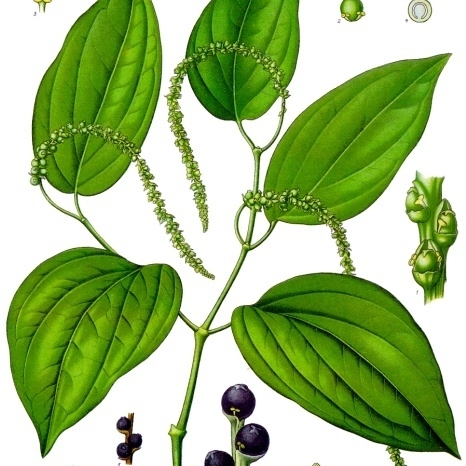Small trees, shrubs, or perennial or annual herbs , often rhizomatous, sometimes aromatic, glabrous, pubescent, or glandular-dotted, terrestrial or epiphytic. Stems simple or branched; vascular bundles in more than 1 ring or scattered. Leaves basal and/or cauline, alternate, opposite, or whorled, simple; stipules present, adnate to petiole; petioles usually present. Leaf blade: margins entire. Inflorescences terminal, opposite leaves, or axillary, spikes. Flowers bisexual; perianth absent, each flower subtended by peltate bract; stamens 2-6, hypogynous, anthers 2-locular; pistil 1, 1-or 3-4-carpellate; ovary 1-locular, superior; placentation basal; ovule 1; stigmas usually 3-4. Fruits drupelike. Seed 1; endosperm scanty; perisperm abundant; embryo minute.
Small trees, shrubs, vines, or herbs; monoecious, dioecious or bisexual. Leaves simple, entire, alternate, opposite or whorled; stipules present or absent. Inflorescences spicate or racemose, pedunculate, axillary, terminal or apparently leaf-opposed, solitary, multiple or numerous and arranged in an umbel. Flowers minute, usually crowded, unisexual or bisexual, each subtended by a peltate bract. Perianth absent. Stamens 2–4. Ovary unilocular; ovule solitary; style present or absent; stigmas 1–5. Fruit pedicellate, subsessile, sessile or immersed in the rachis.
Annual or perennial, often succulent herbs with erect or creeping stems, sometimes epiphytic, or erect sometimes scrambling or climbing subshrubs or shrubs, or lianes, occasionally slender trees (not in the Flora Zambesiaca area), without latex, frequently aromatic; plants dioecious, monoecious or with hermaphrodite flowers
Leaves usually alternate, less often opposite or verticillate, simple, entire, petiolate, thin to very succulent, often glandular-pellucid, pinnately or palmately nerved
Ovary superior, 1-locular, 1-ovulate; ovule basal, orthotropous, erect; styles 1–5 or absent; stigmas 1–5 capitate, linear or penicillate, central or excentric
Inflorescences terminal, axillary or leaf-opposed with flowers in simple, dense and ± fleshy spikes, more rarely in racemes or spikes grouped in umbels
Stamens 2–6 (1–10); filaments thick, usually free; anthers 2-thecous, erect, distinct or confluent, basifixed or dorsifixed, dehiscing longitudinally
Stems with distinct vascular bundles, sometimes scattered as in Monocotyledons, often with jointed and swollen nodes, and often ± zigzag
Fruit an indehiscent drupe (considered a berry by some authors) small, free, sessile or pedunculate with succulent or thin dry pericarps
Flowers minute, mostly hermaphrodite, sometimes unisexual or polygamous, each flower subtended by a minute bract; perianth absent
Leaves usually alternate, entire, rarely opposite or whorled, petiolate, stipules adnate to the petiole or absent
Herbs or shrubs, erect or scandent; vascular bundles more or less scattered, as in Monocotyledones
Stamens 2–6, hypogynous; filaments usually free; anthers 2-celled, distinct or confluent
Flowers minute, hermaphrodite or unisexual, usually densely spicate or spikes umbellate
Seeds small, with small endosperm and copious mealy perisperm; embryo very small
Seed ± globose, with little endosperm but copious perisperm; embryo very small
Ovary superior, 1-celled, 1-ovuled; stigmas 1–5, short; ovule erect
Fruit baccate, small, with a succulent, thin or dry pericarp
Stipules adnate to the petiole, or absent
Perianth absent

